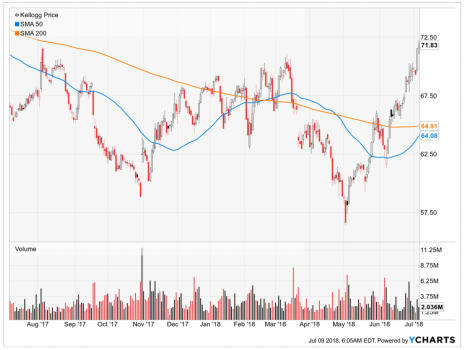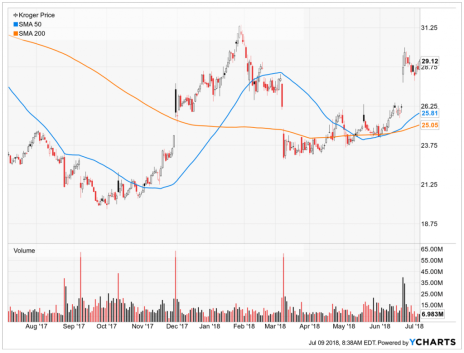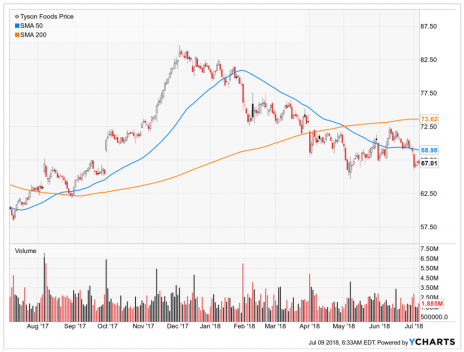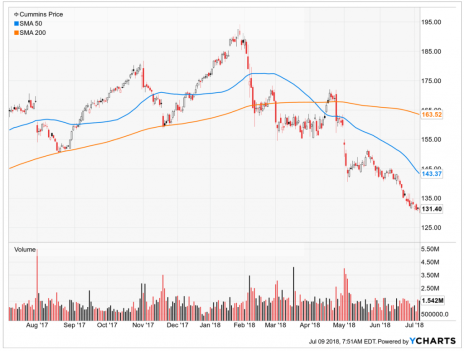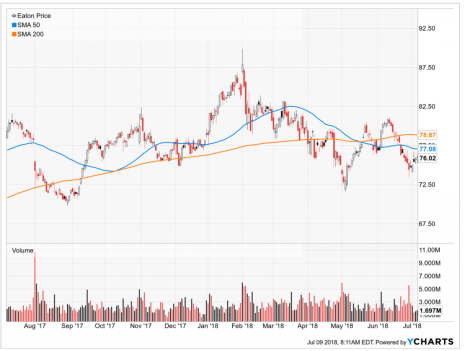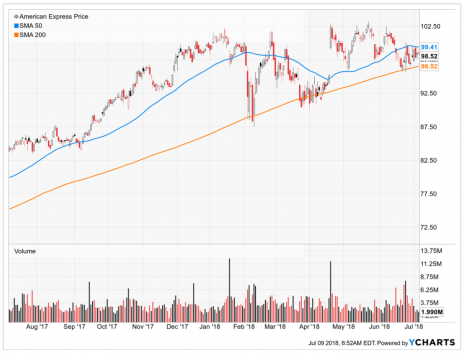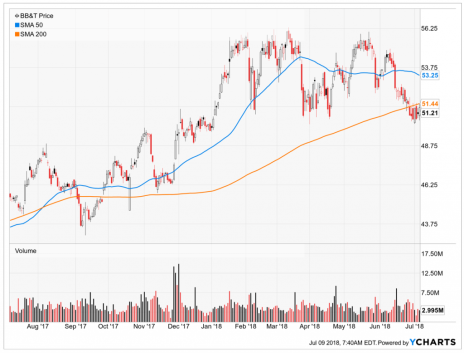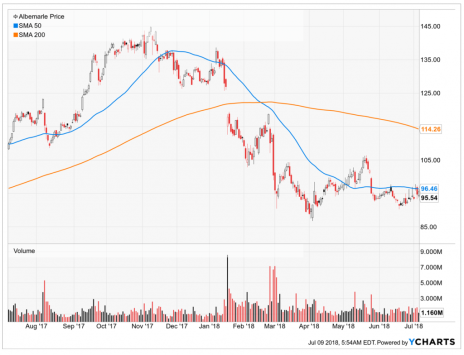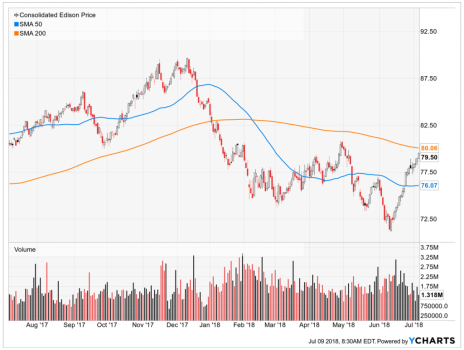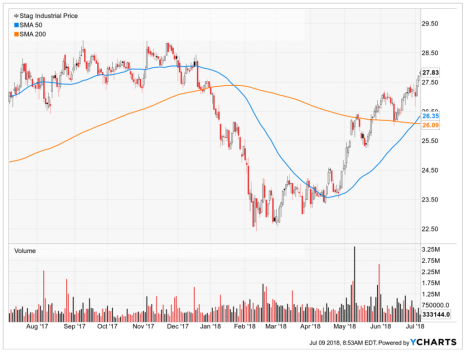In the first half of this two-part series, I looked at which dividend stocks are most undervalued after the first half of 2018. These stocks could see a boost from bottom-fishing investors in the second half. Dividend stocks in general underperformed, as did large-cap stocks and value stocks. The worst performing sectors were consumer staples (down 9.4%, vs. a 1.7% gain for the S&P 500), telecoms (down 6.8%), industrials (down 5.3%), financials (down 4.7%), materials (down 4.1%), REITs (down 1.8%) and utilities (down 1.4%).
Screening for large-cap, undervalued dividend stocks in those sectors left me with 127 candidates for a second-half surge (financials make up over half the list). I narrowed that down based on their charts, valuation ratios, dividend histories, earnings growth expectations and other factors to come up with the 10 undervalued dividend stocks that I think are the best buys for the second half of 2018.
Undervalued Dividend Stock #1: Kellogg Company (K)
Consumer staples stocks were the worst performers of the first half, dragged down by lousy performances from big blue chips like Colgate-Palmolive (CL) and Procter & Gamble (PG). Kellogg wasn’t immune to the selling, but it held its own fairly well, and actually broke out to a new year-to-date high last week. That tells me that if money starts rotating into consumer staples stocks in the second half, Kellogg is likely to be one of the leaders.
The stock meets my other criteria too. It’s big, with a market cap of $25 billion, has a strong dividend yield of 3.0%, and has increased its dividend every year since 2005. EPS are expected to rise 10% this year and 6% next year (revenues are expected to rise by 4% and 2%). The stock isn’t volatile, with a 5-year beta of 0.6, and trades at a P/E of 17 and a forward P/E of 15. Investors looking for a healthy but undervalued dividend stock to bet on a second-half consumer staples rebound will find a lot to like in Kellogg.
Undervalued Dividend Stock #2: The Kroger Corp (KR)
In a related area of the consumer staples space we find Kroger, which owns 2,782 grocery stores in 35 states. Brands include Kroger, Ralphs, Dillons, Smith’s, Fry’s, Harris Teeter and Pick ‘n Save.

Get My Free Report Now

Get My Free Report Now

Get My Free Report Now

Get My Free Report Now
Just over one year ago, Amazon acquired Whole Foods, and the stock of every other grocery store chain in the U.S. dropped like a rock. The selloff has so far proved overdone, and Kroger and peers have gradually recovered over the past 12 months. However, there’s still a lot of skepticism about the industry’s ability to adapt to the Amazon age, and Kroger still trades at a rock-bottom P/E of 7, and a forward P/E of 13.
But the future looks bright. Earnings are expected to grow 4% this year and 7% next year, and estimates have been moving up. In addition, the company has increased its dividend every year for nine years, has a payout ratio of 26%, and the stock yields 1.9% at current prices.
Undervalued Dividend Stock #3: Tyson Foods (TSN)
My final undervalued consumer staples idea also comes from the world of food. Tyson Foods produces about 20% of the beef, pork and chicken consumed in the U.S. In 2017, the company sold about 35 million chickens per week. But about 12% of sales are to international markets, and China is the largest single buyer, so Tyson has been caught in the middle of Trump’s tariff war. That contributed to 15% loss for the stock in the first half, as did the pressure on large cap, dividend-paying consumer staples stocks: TSN has a market cap of $25 billion and a 1.8% dividend yield.
But as with Kroger, the future looks brighter. Analysts expect revenues to rise by 7% this year and 2% next year, driving earnings growth of 23% and 4%. The stock now trades at a P/E of under 10 and a forward P/E of less than 9. And Tyson has increased its dividend every year for six years, but has a payout ratio of only 18%. And while the trade war has entered a new phase, on Wall Street, reality often puts less of a damper on returns than fear.
Undervalued Dividend Stock #4: Cummins (CMI)
Industrial stocks were the third-worst performers of the first half (after telecoms; as I noted yesterday I don’t like any telecom stocks right now). Industrials started the second quarter with a flurry of big-name earnings disappointments and downward guidance revisions, triggering a quick slide that was followed by slower bleeding connected to trade war worries. Engine company Cummins was a casualty of the selloff, although the company also surprised analysts with a big second quarter charge related to a repair program.
The stock, which has a market cap of nearly $22 billion, fell 25% in the first half. That’s brought CMI’s P/E down to 24, and its forward P/E much lower, to just above 9. As suggested by the discrepancy, current-year EPS estimates call for growth of nearly 25%, based on expected sales growth of nearly 13%. Next year sales are expected to rise by 3%, and EPS are expected to rise another 6%.
CMI remains high risk; the stock hasn’t found a bottom yet. But the company has increased its dividend every year for eight years, and currently yields 3.3%, with a payout ratio of 32%. If industrials can turn it around in the second half, I can see the stock being a tempting target for bargain hunters.
Undervalued Dividend Stock #5: Eaton Corp (ETN)
Another industrial stock, Eaton makes power management equipment (everything from residential surge protectors to power plant transformers). The company has a market cap of $33 billion and is based in Ireland, but business is global. ETN fell 5% in the first half, despite reporting earnings that beat estimates in both the fourth and first quarters.
Earnings estimates for the rest of the year have been moving up following the two earnings beats, and analysts now expect EPS growth of 13% this year and 10% next year, fueled by 6% and 4% revenue growth. Despite the solid growth expectations, ETN trades at a P/E of 11 and a forward P/E of 13.
Eaton is a reliable dividend payer, increasing its dividend in each of the last eight years. The company’s current payout ratio of 51% is sustainable, and at current prices, ETN yields a generous 3.5%. This is a stock that has been held down by factors beyond its control, and if industrial stocks in particular, and undervalued dividend stocks in general, can get moving in the second half I assume ETN will be right there with them.
Undervalued Dividend Stock #6: American Express Company (AXP)
Let’s move on to the financials, which fell almost 5% in the first half. American Express, whose primary business is issuing credit cards, has increased its dividend every year since 2012 and yields 1.4%. Analysts expect sales to increase 20% this year, followed by 7% growth next year. That’s expected to fuel EPS growth of 23% and 11%. AXP’s current P/E is high, at 29, but due to the strong earnings growth expectations, it trades at a forward P/E of only 12. Earnings estimates have been moving up, and AXP has beaten expectations in each of the last four quarters.
AXP has a market cap of $85 billion, and has traded primarily sideways since the start of the year, so there’s a good chance that it could pull it together to become one of the leaders of a second-half advance in financials.
AmEx also got a few pieces of good new recently: first, the Supreme Court decided that AmEx’s merchant agreements, which prohibit businesses that accept AmEx from steering customers toward other, cheaper payment methods, don’t violate antitrust laws. Then two weeks ago AmEx passed its Federally-mandated “stress test,” getting permission to buy back up to $3.4 billion of common shares and increase its dividend by 11%. The new annual dividend rate of $1.56 per share will boost AmEx’s yield to about 1.6%, while AmEx’s dividend payout ratio, currently about 19%, will remain solidly in safe territory.
Undervalued Dividend Stock #7: BB&T Corp (BBT)
My second pick from the financial sector is BB&T Corp, a regional bank based in North Carolina. BB&T has a $40 billion market cap and a 2.75% dividend yield, and the stock traded sideways for most of the first half, ending June up 1.5%.
Two weeks ago, regulators gave BB&T permission to increase its dividend by 8%, which is on top of another 13.6% bump announced earlier this year. The new annual dividend rate of $1.62 will boost BBT’s yield to 3.2% at current prices. BB&T also got approval to buy back up to $1.7 billion of stock. This is BB&T’s sixth dividend increase in a row, but the bank has maintained a reasonable payout ratio of 37%.
The stock trades at a P/E of 16 and a forward P/E of 12. And revenues are expected to grow 2% this year and 4% next year, fueling EPS growth of 44% (thanks to a big non-cash boost from tax law changes) and 9%.
Undervalued Dividend Stock #8: Albemarle Corp. (ALB)
From the basic materials sector, we have Albemarle, a specialty chemical company that gets about 36% of revenue from selling lithium. Lithium is an important component in electric cars, as well as most other battery-powered electronic gadgets. Concerns about a supply-demand imbalance, plus the selloff in basic materials stocks, conspired to push ALB down 26% in the first half. However, the stock has been trading sideways since April, and earnings estimates are rising. Analysts now expect Albemarle to report 15% EPS growth this year and 13% growth next year.
ALB now trades at a forward P/E of only 16. And, the company is a reliable dividend payer, raising the payout every year since 2004, with a very reasonable payout ratio of 26%. At current prices, ALB yields about 1.4%.
Undervalued Dividend Stock #9: Consolidated Edison (ED)
Moving on to the utilities, Consolidated Edison boasts one of the longest dividend histories in the industry, and is reasonably priced at its current P/E of 16 and forward P/E of 18.
ConEd provides electricity to New York City and the surrounding area, and has paid dividends since 1975. (Not only has the company paid a dividend for 43 years, they’ve increased it every year too.) ConEd’s current payout ratio of 67% is actually fairly low for a utility, and its current yield of 3.6% is competitive.
The stock has very low volatility, and is a good holding when markets are rocky. ED’s pullback in the first half of this year was caused, in part, by rising interest rate expectations. Dividend-paying utility stocks become less popular with investors when fixed income yields get more competitive. At the same time, the companies see costs rise somewhat because of their heavy reliance on debt.
While interest rates continue to rise gradually, it’s possible that expectations about their trajectory and final resting place have peaked, which would mean the coast is clear for a rebound by ED and its pals.
Undervalued Dividend Stock #10: STAG Industrial (STAG)
Finally, even though no REITs fit all my criteria, I wanted to include at least one, since they were among the first half’s worst performers. My favorite REIT today is STAG Industrial, which owns warehouses and other industrial properties. Demand is soaring for warehouse space as e-commerce companies blanket the country with distribution centers, creating a tailwind for STAG’s business. STAG currently has a yield of 5.1%, and has increased its dividend every year for seven years. Even better (especially if you use income from your investment portfolio to pay the bills) STAG pays distributions monthly.
Thanks to a steady stream of rent increases and acquisitions, STAG has grown funds from operations (a widely-used measure of REIT cash flow) every year since the REIT came public in 2011.
However, the stock corrected 20% as interest rates surged earlier this year, finally finding support in early February. That’s a big drawdown (risk is always higher with high-yield stocks) but signs suggest that rate hike expectations have plateaued for now. STAG started a new uptrend back in March, after interest-rate frenzy peaked, and recently hit a new year-to-date high. If investors continue to rotate back into REITs in the second half, that’s probably just the beginning.
Finally, if you enjoyed these ideas, you should consider coming to our annual Cabot Wealth Summit next month, where I’ll share my top dividend stock ideas (both undervalued and more growth-oriented) for the next full year. You’ll also get the top picks of all the other Cabot analysts (they’re a smart bunch) and lots of strategy tips and techniques for how to deal with them—in any market environment. Just click here to learn more.





